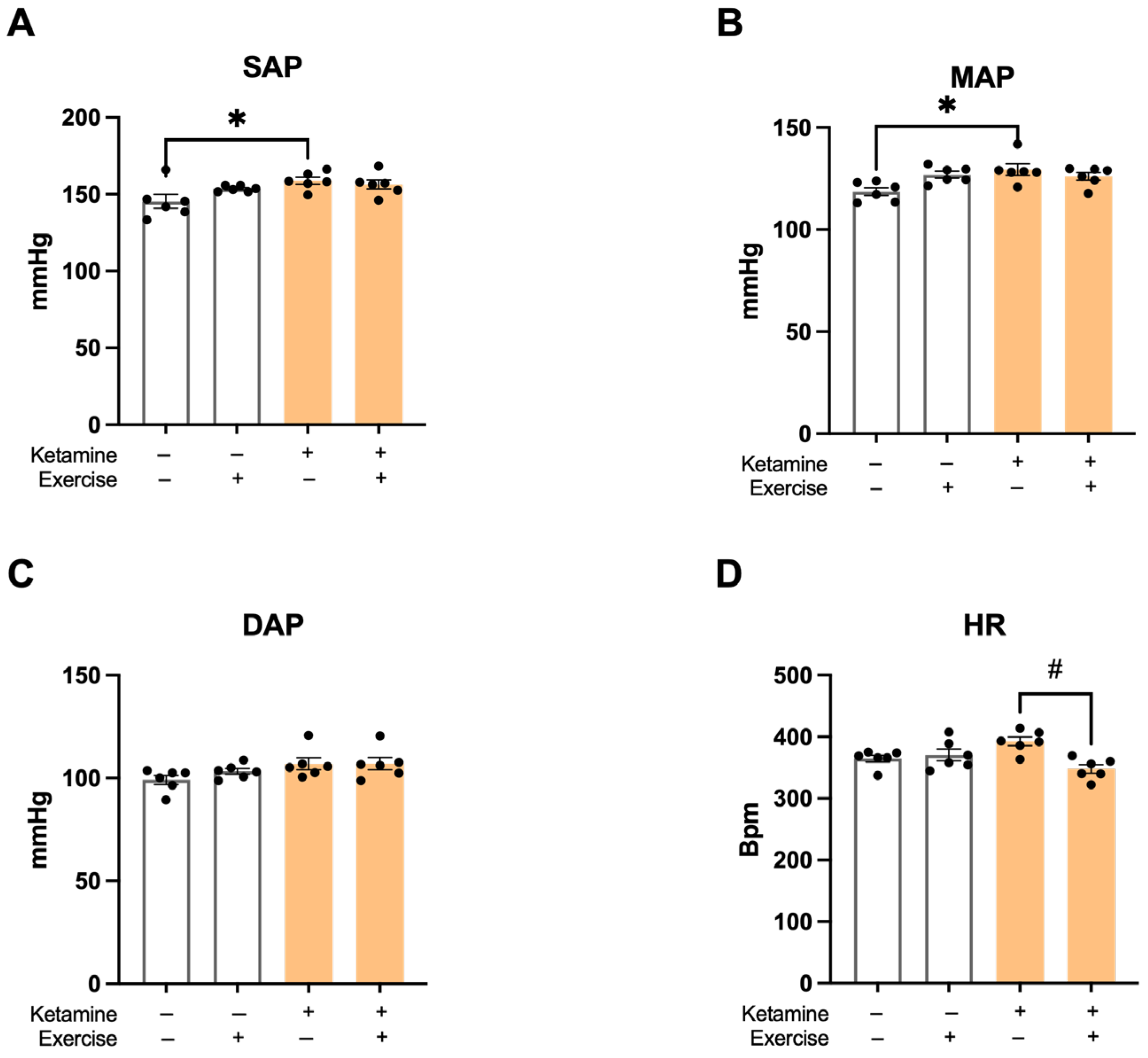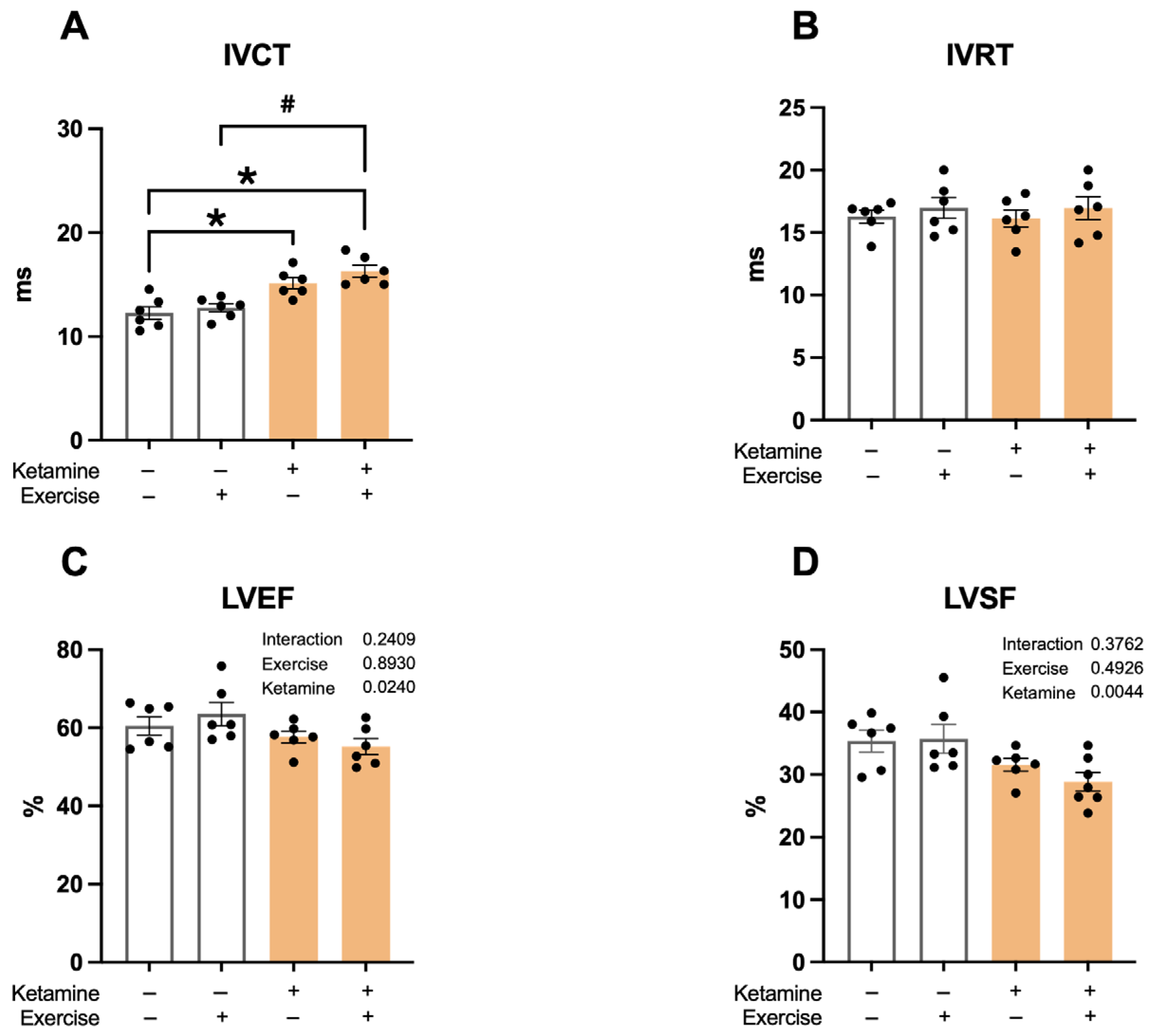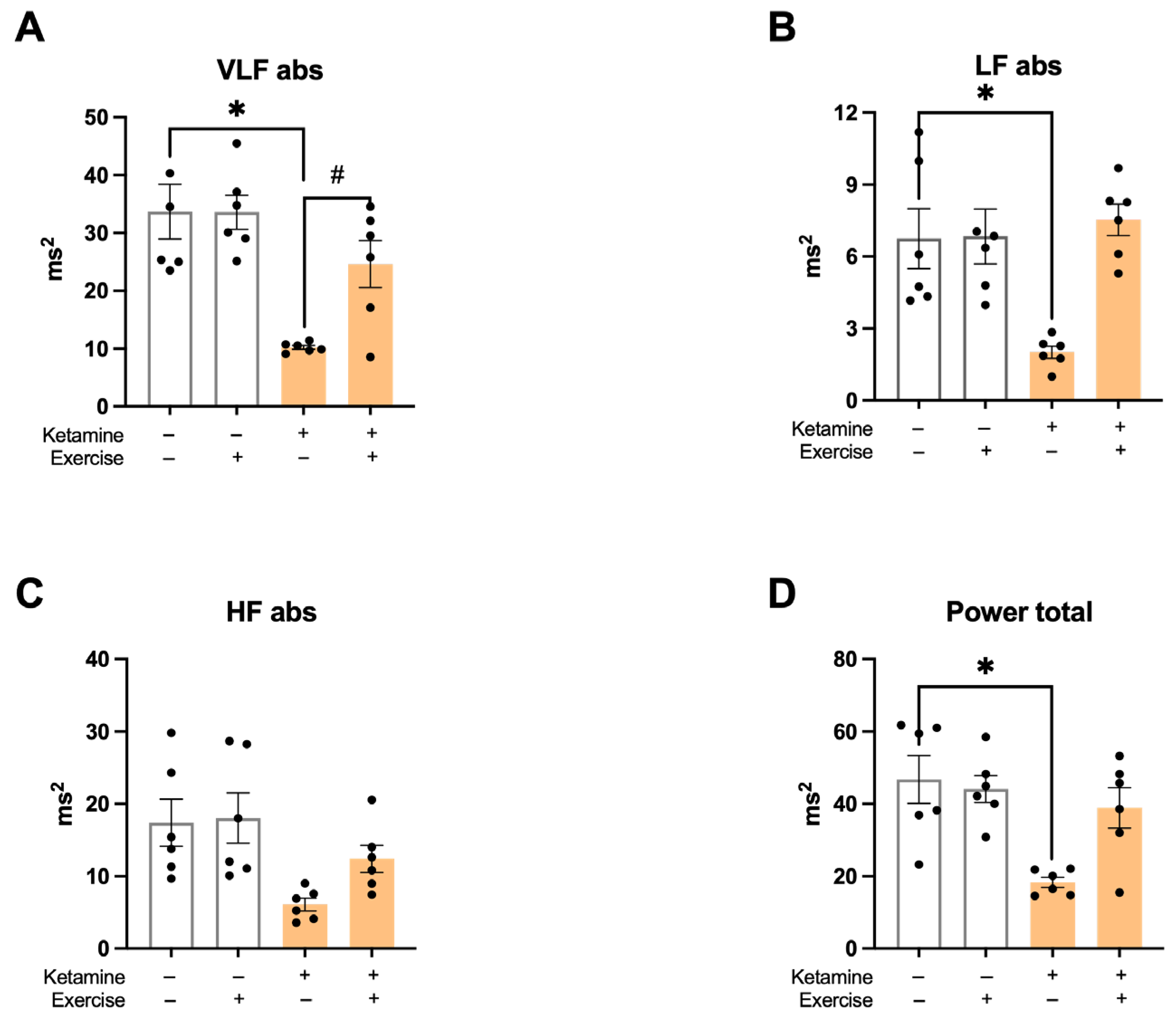Dysfunction in Cardiovascular Autonomic Modulation Caused by Chronic Use of Ketamine Hydrochloride Can Be Prevented by Aerobic Exercise Training in Wistar Rats
Abstract
1. Introduction
2. Materials and Methods
2.1. Animals and Experimental Design
2.2. Ketamine Administration
2.3. Exercise Training Protocol
2.4. Echocardiographic Evaluation
2.5. Hemodynamic and Autonomic Recordings
2.6. Baroreflex Sensitivity Assessment
2.7. Heart Rate and Blood Pressure Variability
2.8. Outcomes Measures
2.9. Statistical Analysis
2.10. Use of Artificial Intelligence
3. Results
3.1. Body Weight and Aerobic Performance
3.2. Hemodynamic Parameters
3.3. Echocardiographic Findings
3.4. Baroreflex Sensitivity
3.5. Heart Rate Variability (HRV)
3.6. Systolic Arterial Pressure Variability (SAPV)
4. Discussion
5. Conclusions
Author Contributions
Funding
Institutional Review Board Statement
Informed Consent Statement
Data Availability Statement
Acknowledgments
Conflicts of Interest
Abbreviations
| AET | Aortic ejection time |
| BRS | Baroreflex sensitivity |
| DAP | Diastolic arterial pressure |
| HF | High frequency band |
| HR | Heart rate |
| HRV | Heart rate variability |
| IVCT | Isovolumetric contraction time |
| LF | Low frequency band |
| LV Vol;d | Left ventricular diastolic volume |
| LV Vol;s | Left ventricular systolic volume |
| LVEF | Left ventricular ejection fraction |
| LVSF | Left ventricular shortening fraction |
| MAP | Mean arterial pressure |
| MPI | Myocardial performance index |
| PI | Pulse interval |
| rMMSD | Root mean square of successive differences |
| S | Sedentary control |
| S-Ket | Sedentary with ketamine |
| SAP | Systolic arterial pressure |
| SD-PI | Standard deviation of pulse interval |
| SEM | Standard error of mean |
| T | Trained control |
| T-Ket | Trained with ketamine |
| Var-PI | Variance of pulse interval |
| VLF | Very low frequency band |
References
- Wolff, K.; Winstock, A.R. From medicine to misuse. CNS Drugs 2006, 20, 199–218. [Google Scholar] [CrossRef] [PubMed]
- Barat, S.A.; Kardos, S.A.; Abdel-Rahman, M.S. Development and validation of a high-performance method for the determination of cocaine and its metabolites. J. Anal. Toxicol. 1996, 16, 215–219. [Google Scholar]
- McGirr, A.; Berlim, M.T.; Bond, D.J.; Fleck, M.P.; Yatham, L.N.; Lam, R.W. A systematic review and meta-analysis of randomized, double-blind, placebo-controlled trials of ketamine in the rapid treatment of major depressive episodes. Psychol. Med. 2015, 45, 693–704. [Google Scholar] [CrossRef]
- Rosenblat, J.D.; Carvalho, A.F.; Li, M.; Lee, Y.; Subramanieapillai, M.; McIntyre, R.S. Oral ketamine for depression: A systematic review. J. Clin. Psychiatry 2019, 80, 18r12475. [Google Scholar] [CrossRef]
- Berman, R.M.; Cappiello, A.; Anand, A.; Oren, D.A.; Heninger, G.R.; Charney, D.S.; Krystal, J.H. Antidepressant effects of ketamine in depressed patients. Biol. Psychiatry 2000, 47, 351–354. [Google Scholar] [CrossRef]
- Al-Harbi, K.S. Treatment-resistant depression: Therapeutic trends, challenges, and future directions. Patient Prefer. Adherence 2012, 6, 369–388. [Google Scholar] [CrossRef]
- Sigtermans, M.J.; van Hilten, J.J.; Bauer, M.C.R.; Arbous, M.S.; Marinus, J.; Sarton, E.Y.; Dahan, A. Ketamine produces effective and long-term pain relief in patients with Complex Regional Pain Syndrome Type 1. Pain 2009, 145, 304–311. [Google Scholar] [CrossRef]
- Eide, P.K.; Jørum, E.; Stubhaug, A.; Bremnes, J.; Breivik, H. Relief of post-herpetic neuralgia with the NMDA receptor antagonist ketamine: A double-blind, cross-over comparison with morphine and placebo. Pain 1994, 58, 347–354. [Google Scholar] [CrossRef]
- Kvarnström, A.; Karlsten, R.; Quiding, H.; Emanuelsson, B.M.; Gordh, T. The effectiveness of intravenous ketamine and lidocaine on peripheral neuropathic pain. Acta Anaesthesiol. Scand. 2003, 47, 868–877. [Google Scholar] [CrossRef]
- Niesters, M.; Martini, C.; Dahan, A. Ketamine for chronic pain: Risks and benefits. Br. J. Clin. Pharmacol. 2014, 77, 357–367. [Google Scholar] [CrossRef]
- Short, B.; Fong, J.; Galvez, V.; Shelker, W.; Loo, C.K. Side-effects associated with ketamine use in depression: A systematic review. Lancet Psychiatry 2018, 5, 65–78. [Google Scholar] [CrossRef] [PubMed]
- Li, L.; Vlisides, P.E. Ketamine: 50 years of modulating the mind. Front. Hum. Neurosci. 2016, 10, 612. [Google Scholar] [CrossRef] [PubMed]
- Li, Y.; Shi, J.; Yang, B.F.; Liu, L.; Han, C.L.; Li, W.M.; Zhang, L. Ketamine-induced ventricular structural, sympathetic and electrophysiological remodelling: Pathological consequences and protective effects of metoprolol. Br. J. Pharmacol. 2012, 165, 1748–1756. [Google Scholar] [CrossRef] [PubMed]
- Gullett, J.M.; O’Shea, A.; Gianaros, P.J.; Ezzati, A.; Benitez, A.; Hishaw, G.A.; Porges, E.C.; Woods, A.J. Brain Age as a Biomarker of Chronic Stress: A Systematic Review. Brain Sci. 2023, 13, 295. [Google Scholar]
- Benarroch, E.E. The arterial baroreflex: Functional organization and involvement in neurologic disease. Neurology 2008, 71, 1733–1738. [Google Scholar] [CrossRef]
- Irigoyen, M.C.; Paulini, J.; Flores, L.J.; Flues, K.; Bertagnolli, M.; Moreira, E.D.; Consolim-Colombo, F.; Belló-Klein, A.; De Angelis, K. Exercise training improves baroreflex sensitivity associated with oxidative stress reduction in ovariectomized rats. Hypertension 2005, 46, 998–1003. [Google Scholar] [CrossRef]
- Jiang, Y.; Wang, Y.; Sun, X.; Lian, B.; Sun, H.; Wang, G.; Du, Z.; Li, Q.; Sun, L. Short- and long-term antidepressant effects of ketamine in a rat chronic unpredictable stress model. Brain Behav. 2017, 7, e00749. [Google Scholar] [CrossRef]
- Rodrigues, B.; Figueroa, D.M.; Mostarda, C.T.; Heeren, M.V.; Irigoyen, M.C.C.; De Angelis, K. Maximal exercise test is a useful method for physical capacity and oxygen consumption determination in streptozotocin-diabetic rats. Cardiovasc. Diabetol. 2007, 6, 38. [Google Scholar] [CrossRef]
- Sanches, I.C.; Conti, F.F.; Bernardes, N.; Brito, J.O.; Galdini, E.G.; Cavaglieri, C.R.; Irigoyen, M.-C.; De Angelis, K. Impact of combined exercise training on cardiovascular autonomic control and mortality in diabetic ovariectomized rats. J. Appl. Physiol. 2015, 119, 656–662. [Google Scholar] [CrossRef]
- Abad, C.C.C.; do Nascimento, A.M.; dos Santos, L.E.; Figueroa, D.; Ramona, P.; Sartori, M.; Scapini, K.B.; Albuquerque, O.; Moraes-Silva, I.C.; Coelho-Júnior, H.J.; et al. Interval and continuous aerobic exercise training similarly increase cardiac function and autonomic modulation in infarcted mice. J. Exerc. Rehabil. 2017, 13, 257–265. [Google Scholar] [CrossRef]
- Task Force of the European Society of Cardiology and the North American Society of Pacing and Electrophysiology. Heart Rate Variability: Standards of Measurement, Physiological Interpretation and Clinical Use. Circulation 1996, 93, 1043–1065. [Google Scholar] [CrossRef]
- Ozili, P.K. The Acceptable R-Square in Empirical Modelling for Social Science Research. In Social Research Methodology and Publishing Results; IGI Global: Hershey, PA, USA, 2023. [Google Scholar]
- Cetin, N.; Suleyman, B.; Altuner, D.; Kuyrukluyildiz, U.; Ozcicek, F.; Coskun, R.; Kurt, N.; Suleyman, H. Effect of disulfiram on ketamine-induced cardiotoxicity in rats. Int. J. Clin. Exp. Med. 2015, 8, 13540–13547. [Google Scholar]
- Ansari, M.; Pittman, B.; Tylee, D.S.; Ostroff, R.; Wilkinson, S.T.; Nikayin, S. Blood Pressure Changes During Ketamine Infusion for the Treatment of Depression. Gen. Hosp. Psychiatry 2024, 90, 62–67. [Google Scholar] [CrossRef] [PubMed]
- Bevan, R.K.; Rose, M.A.; Duggan, K.A. Evidence for Direct Interaction of Ketamine with Alpha 1- and Beta 2-Adrenoceptors. Clin. Exp. Pharmacol. Physiol. 1997, 24, 923–926. [Google Scholar] [CrossRef] [PubMed]
- Draghici, A.E.; Taylor, J.A. The physiological basis and measurement of heart rate variability in humans. J. Physiol. Anthropol. 2016, 35, 8. [Google Scholar] [CrossRef] [PubMed]
- Cruz, P.L.; Moraes-Silva, I.C.; Ribeiro, A.A.; Machi, J.F.; de Melo, M.D.T.; dos Santos, F.; da Silva, M.B.; Strunz, C.M.C.; Caldini, E.G.; Irigoyen, M.-C.; et al. Nicotinamide attenuates streptozotocin-induced diabetes complications and increases survival rate in rats: Role of autonomic nervous system. BMC Endocr. Disord. 2021, 21, 133. [Google Scholar] [CrossRef]
- Moraes-Silva, I.C.; Mostarda, C.; Moreira, E.D.; Augusto, K.; Silva, S.; Santos, F.; De Angelis, K.; de Moura Azevedo Farah, V.; Irigoyen, M.C. Preventive role of exercise training in autonomic, hemodynamic, and metabolic parameters in rats under high risk of metabolic syndrome development. J. Appl. Physiol. 2013, 114, 786–791. [Google Scholar] [CrossRef]
- Mostarda, C.; Rodrigues, B.; Vane, M.; Moreira, E.D.; Rosa, K.; Moraes-Silva, I.C.; Lacchini, S.; E Casarini, D.; De Angelis, K.; Irigoyen, M.C. Autonomic impairment after myocardial infarction: Role in cardiac remodelling and mortality. Clin. Exp. Pharmacol. Physiol. 2010, 37, 447–452. [Google Scholar] [CrossRef]
- Rodrigues, B.; Mostarda, C.T.; Jorge, L.; Barboza, C.A.; Grans, C.F.; De Angelis, K.; Irigoyen, M.C. Impact of myocardial infarction on cardiac autonomic function in diabetic rats. J. Diabetes Complicat. 2013, 27, 16–22. [Google Scholar] [CrossRef]
- Szarmach, J.; Cubała, W.J.; Włodarczyk, A.; Wiglusz, M.S. Short-Term Ketamine Administration in Treatment-Resistant Depression: Focus on Cardiovascular Safety. Psychiatr. Danub. 2019, 31 (Suppl. S3), 585–590. [Google Scholar]
- Aubert, A.E.; Seps, B.; Beckers, F. Heart Rate Variability in Athletes. Sports Med. 2003, 33, 889–919. [Google Scholar] [CrossRef]
- Carter, J.B.; Banister, E.W.; Blaber, A.P. The Effect of Endurance Training on Autonomic Regulation of Heart Rate. Sports Med. 2003, 33, 33–46. [Google Scholar] [CrossRef]
- Chen, Y.W.; Sherpa, A.D.; Aoki, C. Single injection of ketamine during mid-adolescence promotes long-lasting resilience to activity-based anorexia of female mice by increasing food intake and attenuating hyperactivity as well as anxiety-like behavior. Int. J. Eat. Disord. 2018, 51, 1020–1025. [Google Scholar] [CrossRef]
- Rotroff, D.M.; Corum, D.G.; Fiehn, O.; Bottrel, N.; Drevets, W.C.; Singh, J.; Salvadore, G.; Kaddurah-Daouk, R. Metabolomic signatures of drug response phenotypes for ketamine and esketamine in subjects with refractory major depressive disorder: New mechanistic insights for rapid acting antidepressants. Transl. Psychiatry 2016, 6, e894. [Google Scholar] [CrossRef] [PubMed]
- Kraus, C.; Castrén, E.; Kasper, S.; Lanzenberger, R. Serotonin and neuroplasticity—Links between molecular, functional and structural pathophysiology in depression. Neurosci. Biobehav. Rev. 2017, 77, 317–326. [Google Scholar] [CrossRef] [PubMed]
- Cordeiro, L.M.S.; Rabelo, P.C.R.; Moraes, M.M.; Coimbra, C.C. Physical exercise-induced fatigue: The role of serotonergic and dopaminergic systems. Neurosci. Biobehav. Rev. 2017, 50, e6432. [Google Scholar] [CrossRef] [PubMed]
- Miki, K.; Yoshimoto, M. Exercise-induced modulation of baroreflex control of sympathetic nerve activity. Front. Neurosci. 2018, 12, 493. [Google Scholar] [CrossRef]
- Fu, Q.; Levine, B.D. Exercise and the autonomic nervous system. In Handbook of Clinical Neurology, 3rd ed.; Elsevier: Houston, TX, USA, 2013; pp. 147–160. [Google Scholar]
- Moraes-Silva, I.; De La Fuente, R.; Mostarda, C.; Rosa, K.; Flues, K.; Damaceno-Rodrigues, N.; Caldini, E.; De Angelis, K.; Krieger, E.; Irigoyen, M. Baroreflex deficit blunts exercise training-induced cardiovascular and autonomic adaptations in hypertensive rats. Clin. Exp. Pharmacol. Physiol. 2010, 37, e114–e120. [Google Scholar] [CrossRef]
- Billman, G.E.; Cagnoli, K.L.; Csepe, T.; Li, N.; Wright, P.; Mohler, P.J.; Fedorov, V.V. Exercise training-induced bradycardia: Evidence for enhanced parasympathetic regulation without changes in intrinsic sinoatrial node function. J. Appl. Physiol. 2015, 118, 1344–1355. [Google Scholar] [CrossRef]
- Billman, G.E. Cardiac autonomic neural remodeling and susceptibility to sudden cardiac death: Effect of endurance exercise training. Am. J. Physiol. Heart Circ. Physiol. 2009, 297, H1171–H1193. [Google Scholar] [CrossRef]
- Meyer, T.; Brunovsky, M.; Horacek, J.; Novak, T.; Andrashko, V.; Seifritz, E.; Olbrich, S. Predictive value of heart rate in treatment of major depression with ketamine in two controlled trials. Clin. Neurophysiol. 2021, 132, 1339–1346. [Google Scholar] [CrossRef]
- Becker, K.; Seiwert, N.; Jäger, R.; Schneider, B.; Höfler, I.; Heine, H.; Weigt, H.; Chovolou, Y.; Kamp, H.; Abel, J.; et al. Cisplatin-induced DNA damage and cytotoxicity are potentiated by resveratrol in human ovarian cancer cells. Toxicol. Lett. 2019, 313, 86–96. [Google Scholar]
- Macleod, M.R.; Lawson McLean, A.; Kyriakopoulou, A.; Serghiou, S.; de Wilde, A.; Sherratt, N.; Hirst, T.; Hemblade, R.; Bahor, Z.; Nunes-Fonseca, C.; et al. Risk of Bias in Reports of In Vivo Research: A Focus for Improvement. PLoS Biol. 2015, 13, e1002273. [Google Scholar] [CrossRef]





| Groups Measurements | S | S-Ket | T | T-Ket | ||
|---|---|---|---|---|---|---|
| p value ANOVA | p value GLM | |||||
| Doppler Flux | ||||||
| AET (ms) | 64 ± 1.0 | 61 ± 1.4 | 64 ± 0.9 | 62 ± 1.4 | 0.2274 | <0.05 # |
| MPI | 0.47 ± 0.0 | 0.57 ± 0.0 | 0.48 ± 0.0 | 0.55 ± 0.0 | 0.2243 | <0.05 # |
| Morphometric Measurements | ||||||
| LV Vol;d (µL) | 296 ± 16 | 276 ± 12 | 231 ± 11 | 256 ± 26 | 0.1345 | <0.05 * |
| LV Vol;s (µL) | 118 ± 8 | 117 ± 10 | 82 ± 11 | 95 ± 10 | 0.0576 | <0.05 * |
| LA/Ao | 0.7 ± 0.0 | 0.6 ± 0.0 | 0.7 ± 0.0 | 0.6 ± 0.0 | 0.2144 | <0.05 # |
| Groups Measurements | S | S-Ket | T | T-Ket | ||
|---|---|---|---|---|---|---|
| p value ANOVA | p value GLM | |||||
| HRV (time domain) | ||||||
| SD-PI (ms) | 8.6 ± 0.7 | 7.1 ± 0.6 | 8.5 ± 0.8 | 10.3 ± 1.1 | 0.14 | - |
| Var-PI (ms2) | 69.8 ± 13 | 45.9 ± 7 | 76.7 ± 14 | 79.9 ± 27 | 0.60 | - |
| rMSSD (ms) | 7.2 ± 0.6 | 4.8 ± 0.5 # | 7.1 ± 0.7 | 6.3 ± 0.7 # | 0.07 | <0.05 |
| SAPV (time and frequency domain) | ||||||
| SD-SAP (mmHg) | 5.3 ± 0.5 | 6.2 ± 0.7 | 5.9 ± 0.5 | 4.7 ± 0.2 | 0.20 | - |
| Var-SAP (mmHg2) | 25.4 ± 1.8 | 46.3 ± 9.2 * | 29.1 ± 6.2 * | 23.3 ± 1.3 * | 0.00 | <0.05 |
| LF-SAP (mmHg2) | 5.9 ± 0.7 | 6.1 ± 1.1 | 7.0 ± 1.3 | 5.4 ± 0.4 | 0.68 | - |
Disclaimer/Publisher’s Note: The statements, opinions and data contained in all publications are solely those of the individual author(s) and contributor(s) and not of MDPI and/or the editor(s). MDPI and/or the editor(s) disclaim responsibility for any injury to people or property resulting from any ideas, methods, instructions or products referred to in the content. |
© 2025 by the authors. Licensee MDPI, Basel, Switzerland. This article is an open access article distributed under the terms and conditions of the Creative Commons Attribution (CC BY) license (https://creativecommons.org/licenses/by/4.0/).
Share and Cite
Dos-Santos, A.; dos Santos, L.P.F.; da Silva-Santos, G.; da Silva, B.D.; Nascimento-Carvalho, B.; de Souza-Lima, H.D.; da Costa-Santos, N.; Caperuto, E.C.; Bernardes, N.; De Angelis, K.; et al. Dysfunction in Cardiovascular Autonomic Modulation Caused by Chronic Use of Ketamine Hydrochloride Can Be Prevented by Aerobic Exercise Training in Wistar Rats. J. Clin. Med. 2025, 14, 7548. https://doi.org/10.3390/jcm14217548
Dos-Santos A, dos Santos LPF, da Silva-Santos G, da Silva BD, Nascimento-Carvalho B, de Souza-Lima HD, da Costa-Santos N, Caperuto EC, Bernardes N, De Angelis K, et al. Dysfunction in Cardiovascular Autonomic Modulation Caused by Chronic Use of Ketamine Hydrochloride Can Be Prevented by Aerobic Exercise Training in Wistar Rats. Journal of Clinical Medicine. 2025; 14(21):7548. https://doi.org/10.3390/jcm14217548
Chicago/Turabian StyleDos-Santos, Adriano, Lucas Porto Fernandes dos Santos, Gabriela da Silva-Santos, Bruno Durante da Silva, Bruno Nascimento-Carvalho, Hunter Douglas de Souza-Lima, Nicolas da Costa-Santos, Erico Chagas Caperuto, Nathalia Bernardes, Katia De Angelis, and et al. 2025. "Dysfunction in Cardiovascular Autonomic Modulation Caused by Chronic Use of Ketamine Hydrochloride Can Be Prevented by Aerobic Exercise Training in Wistar Rats" Journal of Clinical Medicine 14, no. 21: 7548. https://doi.org/10.3390/jcm14217548
APA StyleDos-Santos, A., dos Santos, L. P. F., da Silva-Santos, G., da Silva, B. D., Nascimento-Carvalho, B., de Souza-Lima, H. D., da Costa-Santos, N., Caperuto, E. C., Bernardes, N., De Angelis, K., Irigoyen, M. C., Scapini, K. B., & Sanches, I. C. (2025). Dysfunction in Cardiovascular Autonomic Modulation Caused by Chronic Use of Ketamine Hydrochloride Can Be Prevented by Aerobic Exercise Training in Wistar Rats. Journal of Clinical Medicine, 14(21), 7548. https://doi.org/10.3390/jcm14217548







